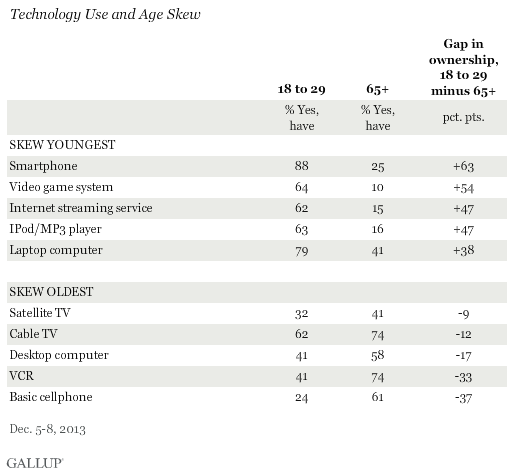WASHINGTON, D.C. -- The International Consumer Electronics Show (CES) this week allows technology developers to showcase the latest gadgets that may become must-haves for many Americans. As attendees get a glimpse of the industry's future, Gallup finds that the devices Americans own have changed over the past decade, with ownership of laptops (64%) and iPods/MP3 players (45%) up most dramatically from 2005. Meanwhile, far smaller proportions of Americans now own VCRs and basic cellphones, which were a staple to many in the past.

These results come from a Dec. 5-8 Gallup telephone survey of 1,031 national adults, with roughly half of the respondents reached on cellphones and half on landlines.
Technology and consumer electronics is a dynamic field; devices that are commonplace can quickly become obsolete as new products emerge. That Gallup did not ask about a number of electronic products and services in 2005 that were included in the current update is testimony to these changes.
Compared with 2005, fewer Americans today have desktop computers, VCRs, and basic cellphones, while there have been substantial increases in ownership of MP3 players and laptops, with slight increases in ownership of video game systems and satellite TV. Meanwhile, most Americans say they have Internet access at home through Wi-Fi (73%) or have smartphones with Web access (62%).
Still, even in the face of such rapid innovation, some items have showed remarkable staying power since 2005. Ownership of cable TV (68%) has not changed, even as speculation abounds that Internet streaming services such as Hulu, Netflix, or Roku could displace cable. Essentially the same share of Americans own DVD or Blu-ray players as in 2005, 80%, and this is the most commonly owned electronic device.
Generational Differences in Technology Ownership
The youngest American adults -- those aged 18 to 29 -- favor a different portfolio of technology devices than their older compatriots do. Smartphone ownership among the young is nearly universal (88%), and it is the most common device among this group. Eighty-three percent of 18- to 29-year-olds have wireless Internet access at home, and another 79% have a laptop.

Less common among younger Americans are items that are familiar to individuals of a different generation -- about four in 10 younger Americans have a VCR (41%), and an identical percentage have a desktop computer. Meanwhile, a basic cellphone, which 86% of 18- to 29-year-olds owned in 2005, is now the least commonly owned technology device among this age group (24%).
This is not to say that older generations have been left behind as technology changes. Recent research suggests that the largest growth in Facebook over the past year came from the oldest cohort of Americans, aged 65 and older. But older Americans are most likely to have older forms of technology, including cable TV (74%) and the now essentially obsolete VCR (74%), although 70% own DVD players. A majority of Americans aged 65 and older own a basic cellphone (61%), while one-quarter own a smartphone.
About half of older Americans have wireless Internet access in their homes. Portable Internet-based or Internet-providing devices are less popular with American seniors: one-quarter have tablet computers, while 16% have an iPod or MP3 player and 15% have an Internet streaming service. Video game systems are the least popular electronic product among older Americans, at 10%.

All in all, the five devices that skew the youngest are smartphones, video game systems, Internet streaming services, iPod or MP3 players, and laptop computers. And the five devices that skew the oldest are satellite TV, cable TV, desktop computers, VCRs, and basic cellphones.

Bottom Line
The week's CES show could unveil another electronic device that will soon be ubiquitous in American life. Of course, in the process, these new devices will begin displacing other popular technology. The constantly evolving nature of the technology scene is why so many people find it exciting, and as this Gallup poll shows, technology ownership has changed dramatically since 2005. Portable Internet-connected devices such as laptops and smartphones are generally more favored, while older forms of technology such as desktop computers, VCRs, and basic cellphones are falling out of fashion.
Survey Methods
Results for this Gallup poll are based on telephone interviews conducted Dec 5-8, 2013, on the Gallup Daily tracking survey, with a random sample of 1,031 adults, aged 18 and older, living in all 50 U.S. states and the District of Columbia.
For results based on the total sample of national adults, the margin of sampling error is ±4 percentage points at the 95% confidence level.
Interviews are conducted with respondents on landline telephones and cellular phones, with interviews conducted in Spanish for respondents who are primarily Spanish-speaking. Each sample of national adults includes a minimum quota of 50% cellphone respondents and 50% landline respondents, with additional minimum quotas by region. Landline and cell telephone numbers are selected using random-digit-dial methods. Landline respondents are chosen at random within each household on the basis of which member had the most recent birthday.
Samples are weighted to correct for unequal selection probability, nonresponse, and double coverage of landline and cell users in the two sampling frames. They are also weighted to match the national demographics of gender, age, race, Hispanic ethnicity, education, region, population density, and phone status (cellphone only/landline only/both, and cellphone mostly). Demographic weighting targets are based on the March 2012 Current Population Survey figures for the aged 18 and older U.S. population. Phone status targets are based on the July-December 2011 National Health Interview Survey. Population density targets are based on the 2010 census. All reported margins of sampling error include the computed design effects for weighting.
In addition to sampling error, question wording and practical difficulties in conducting surveys can introduce error or bias into the findings of public opinion polls.
View methodology, full question results, and trend data.
For more details on Gallup's polling methodology, visit www.gallup.com.
